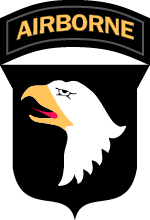101st Airborne Division

The 101st Airborne Division was activated on August 16, 1942 at Camp Claiborne, Louisiana under the command of General William C. Lee. The 101st had previously existed as a non-airborne unit during and after World War I, but had never entered combat and was never fully manned or operational.
Training of the 101st, which had been designated as an airborne unit on August 28, 1942, began in October of 1942 at Fort Benning, Georgia, and by July of the next year the division was considered trained and ready for combat.
On September 5, 1943, the 101st Airborne Division departed New York and set sail for England. Further training commenced on English soil, and command of the division was transferred to Major General Maxwell Taylor after General Lee suffered a heart attack.
For Operation Overlord, the 101st Airborne Division was given the following objectives:
- Secure the four causeway exits behind Utah Beach
- Disrupt German communications
- Setup roadblocks to hamper German movements
- Capture Sainte-Come-du-Mont
- Destroy coastal batteries including the Saint-Germain-de-Varreville battery
- Capture and destroy bridges on the Carentan causeway, and those spanning the Douve River at Brevands
- Capture Douve River lock at la Barquette
- Reach Highway 13 at Les Forges
- Link up with the 82nd Airborne
- Secure the Douve River valley
Pathfinders from the 101st landed in Normandy just after midnight on June 6th, 1944. Carried aboard 11 C-47 transport planes, these forces were to mark three drop zones for the division's three parachute infantry regiments.
The three regiments of the 101st were dropped behind Utah Beach early in the morning of June 6th, roughly one hour after the pathfinders. 6,789 paratroopers were carried aboard 432 C-47's, of which 38 planes were lost. Most of the paratroopers landed far from their planned drop zones, but despite this and other setbacks they quickly organized into groups and set out to complete their assigned objectives.
By the end of the day Utah Beach was secure and the 4th Infantry Division had made contact with 101st and 82nd paratroopers. The 101st was next tasked with linking up with the forces that had landed on Omaha Beach, and after fighting their way through St. Come du Mont, Carentan and Rouxeville, the 101st made contact with the 29th Infantry Division, thus linking the Utah and Omaha Beach forces. The 101st continued fighting in France until July when they were withdrawn in order to prepare for an attack on Holland.
The 101st Airborne Division went on to participate in Operation Market-Garden in Holland in September of 1944, the defense of Bastogne, Belgium in December of 1944 during the German Ardennes Offensive (The Battle of the Bulge), actions in the Ruhr River valley in Germany in April of 1945, and an attack on Berchtesgaden, Bavaria, the location of Hitler's "Eagle's Nest" vacation retreat. The 101st remained in occupied Germany until November of 1945, after which the unit was sent to France, deactivated, and returned to the United States.
The division would later participate in the Vietnam War from 1965 through 1972 (having been redesignated as an Air Cavalry Division on August 5, 1968, and then back to an Airborne Division on September 10, 1968), Operation Desert Storm from 1990 through 1991, as well as missions in Rwanda, Haiti, Somalia and Bosnia. In early 2002 the 101st was sent to Afghanistan, and in March of 2003 the Screaming Eagles participated in Operation Iraqi Freedom. The 101st, which had been redesignated as an Air Assault Division in 1974, is currently based at Fort Campbell, Kentucky.
The shoulder sleeve insignia of the 101st Airborne Division features a bald eagle's head on a black 2 1/2 inch shield over which is a curved black tab with the words "AIRBORNE" in yellow in all capitals. The black shield's color symbolizes the "Iron Brigade" of the State of Wisconsin, from where the original 101st Division hailed. One of the Iron Brigade's regiments featured a war eagle named Old Abe. The insignia was authorized for use by the original 101st Division on May 23, 1923.
